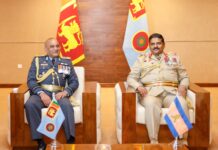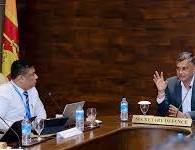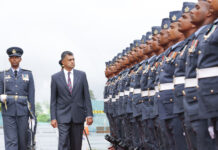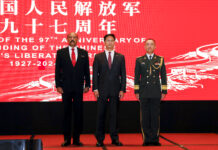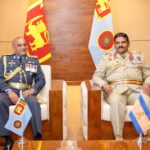By the late 1980s, the insurgency in Sri Lanka’s north was taking on aspects of a significant conflict. The Liberation Tigers of Tamil Eelam (LTTE) had consolidated their disparate rebel groups and were posing a substantial threat to the state. As the struggle escalated, the use of air power was seen as a critical edge for the government’s forces.
The Sri Lanka Air Force (SLAF) had shed most of its combat capabilities with the small fleet of Mikoyan-Gurevich MiG-17s and a solitary MiG-15UTI two-seat trainer, in service with the SLAF and its nominal predecessor the RCyAF (Royal Ceylon Air Force) since 1971, being retired in the late 1970s. At the onset of hostilities with the Tamil Tiger rebels, the service was focusing its resources on transport and helicopter operations.
The latest acquisitions initially comprised helicopters, with several Bell 212s and 412s being inducted, some with offensive capabilities. The first fixed-wing type acquired for combat duty was the SIAI-Marchetti SF.260TP single-engine turboprop, a training aircraft adapted for ground attack duties, introduced in 1985. A variant of the Lycoming piston engine-powered SF.260W Warrior also used by the SLAF, the SF.260TP was capable and accurate in the hands of a skilled pilot, although it was “…vulnerable to ground fire and had a very limited payload” in the words of Air Chief Marshal Kolitha Gunatilleke, who commanded the squadron.
A mix of seven jet fighters produced in China — two Shenyang FT-5 trainers (based on the MiG-17); a solitary Guizhou FT-7 (MiG-21) trainer; and four Chengdu F-7BS ground attack aircraft (based on the MiG-21 too) — were also acquired in 1991, the first fast jets operated by the SLAF since the retirement of Soviet-supplied MiG-17s and MiG-15UTI. These latest Chinese aircraft were used for some ground attack missions, but were soon supplemented by the FMA IA 58 Pucará.
This Argentina-designed and -produced twin-turboprop (Pucará means ‘fortress’ in Quechua, a pre-Colombian language from the Andes region) had seen combat in the Falklands War, proving effective against the far superior British forces, thus earning the respect of enemy infantry who had to face them. Some Pucarás had even evaded the Royal Navy’s Sea Harriers in combat, a commendable feat for a turboprop against a state-of-the-art jet fighter.

With a sleek profile, a relatively high cruise speed, armour plating, two 20mm cannon and four machine guns, the Pucará was purpose-built for a low-intensity conflict in a counter-insurgency (COIN) role. Designed to operate from short unpaved strips with minimal ground support, simplicity was a key feature of the aircraft. In some ways it was a direct descendant, albeit with much better engines, of German designs from the Second World War, such as the Messerschmidt Bf 110. Rumour has it that German aeronautical designers who had moved to Argentina after the war were the architects of the type, but this is hard to verify.
In 1992 the SLAF procured two Pucarás from the Argentine Air Force. Attached to No 1 Flying Training wing based in Anuradhapura, they were designated with SLAF serials (military ‘registrations’) CA-601 and -602. The type’s versatility and simplicity of operation prompted the SLAF to acquire another two in 1993. This small fleet provided extensive close-air support to Sri Lanka Army troops until 1997, with the Pucarás’ speed and firepower providing a significant tactical advantage at that stage of the war.

The Pucará was a “…pleasure to fly”, according to ACM Gunatilleke. “My instructors carried out a dual role — training cadet pilots and conducting combat missions, flying the Pucará as a single-pilot. The aircraft was very simple to fly, with excellent visibility. It was easy to maintain and had good single-engine capabilities, though we had no problems with the engines during the time we operated the airplane. It was a purely ‘visual’ machine, with a basic gunsight and almost no avionics. The range was excellent, allowing us to operate out of Anuradhapura most of the time, though we would occasionally detach and base out of Palaly in the Jaffna peninsula, the epicentre of the conflict.”
ACM Gunatilleke continues: “One issue with the Pucará was the fact that it had no oxygen system, so was limited to relatively low altitudes. We did some extended maritime patrolling looking for LTTE shipping, but this had to be at 10,000 feet due to the lack of supplementary oxygen for the pilot. We also experimented with ‘classic’ high-altitude (about 12,000 feet) bombing missions from level flight, but these were not accurate. The principal vulnerability was that the Pucará could not be equipped with counter-measures against surface to air missiles (SAMs). Once the LTTE acquired these, the Pucará’s days were numbered.”
One aircraft (CA-605) was hit by ground fire over the Kilaly lagoon but made it back to Palaly airbase. This aircraft is currently on display at the SLAF museum in Ratmalana. CA-601 was downed by a surface to air missile (SAM), being one of the first such attacks by the LTTE, in July 1995. The pilot Flt. Lt. Dilhan Perera, who was trying a ‘LOW-POP UP-LOW’ profile within the Jaffna peninsula was killed. “The SAM was on the enemy’s front line. He didn’t have a chance.” says AM Gunatilleke sadly.
Soon afterwards, CA-604 was destroyed at night while on a bombing mission. There was no evidence of enemy fire, so it is surmised that the ordnance on board detonated prematurely. Fortunately, the pilot ejected and survived to have a long career in the SLAF, rising to the rank of Air Vice Marshal.
This accident caused the retirement of the Pucará fleet, as only one aircraft was operational. With the enemy’s acquisition of SAMs, the air war was escalated with the SLAF procuring Mil MI-24 helicopter gunships, the feared Hind (to use its NATO reporting code-name) made notorious by Soviet forces in Afghanistan. The four Chengdu F-7BS ground attack aircraft introduced in 1991 were, in fact, used to replace the Pucarás. However, due to the F-7’s poor payload of only two 250kg bombs, the latter type proved inadequate. Consequently, the SLAF acquired a number of Israeli Aircraft Industries (IAI) Kfir C.2 jets and MiG-27 ‘swing-wing’ Flogger ground attack aircraft as the conflict escalated into a full-scale war.




